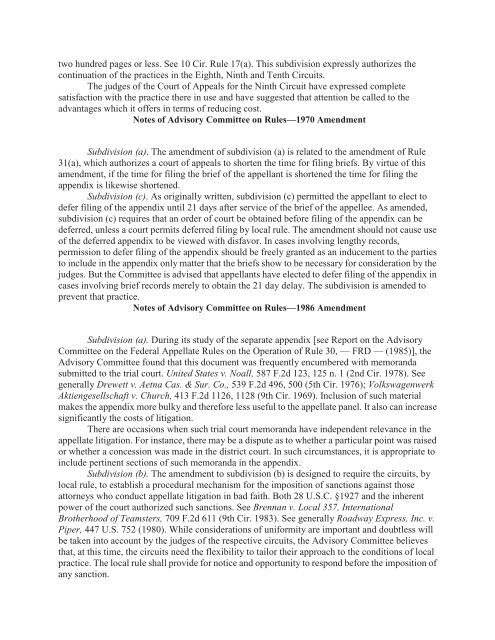Federal Rules of Appellate Procedure 2014-2015, 2014a
Federal Rules of Appellate Procedure 2014-2015, 2014a
Federal Rules of Appellate Procedure 2014-2015, 2014a
Create successful ePaper yourself
Turn your PDF publications into a flip-book with our unique Google optimized e-Paper software.
two hundred pages or less. See 10 Cir. Rule 17(a). This subdivision expressly authorizes the<br />
continuation <strong>of</strong> the practices in the Eighth, Ninth and Tenth Circuits.<br />
The judges <strong>of</strong> the Court <strong>of</strong> Appeals for the Ninth Circuit have expressed complete<br />
satisfaction with the practice there in use and have suggested that attention be called to the<br />
advantages which it <strong>of</strong>fers in terms <strong>of</strong> reducing cost.<br />
Notes <strong>of</strong> Advisory Committee on <strong>Rules</strong>—1970 Amendment<br />
Subdivision (a). The amendment <strong>of</strong> subdivision (a) is related to the amendment <strong>of</strong> Rule<br />
31(a), which authorizes a court <strong>of</strong> appeals to shorten the time for filing briefs. By virtue <strong>of</strong> this<br />
amendment, if the time for filing the brief <strong>of</strong> the appellant is shortened the time for filing the<br />
appendix is likewise shortened.<br />
Subdivision (c). As originally written, subdivision (c) permitted the appellant to elect to<br />
defer filing <strong>of</strong> the appendix until 21 days after service <strong>of</strong> the brief <strong>of</strong> the appellee. As amended,<br />
subdivision (c) requires that an order <strong>of</strong> court be obtained before filing <strong>of</strong> the appendix can be<br />
deferred, unless a court permits deferred filing by local rule. The amendment should not cause use<br />
<strong>of</strong> the deferred appendix to be viewed with disfavor. In cases involving lengthy records,<br />
permission to defer filing <strong>of</strong> the appendix should be freely granted as an inducement to the parties<br />
to include in the appendix only matter that the briefs show to be necessary for consideration by the<br />
judges. But the Committee is advised that appellants have elected to defer filing <strong>of</strong> the appendix in<br />
cases involving brief records merely to obtain the 21 day delay. The subdivision is amended to<br />
prevent that practice.<br />
Notes <strong>of</strong> Advisory Committee on <strong>Rules</strong>—1986 Amendment<br />
Subdivision (a). During its study <strong>of</strong> the separate appendix [see Report on the Advisory<br />
Committee on the <strong>Federal</strong> <strong>Appellate</strong> <strong>Rules</strong> on the Operation <strong>of</strong> Rule 30, — FRD — (1985)], the<br />
Advisory Committee found that this document was frequently encumbered with memoranda<br />
submitted to the trial court. United States v. Noall, 587 F.2d 123, 125 n. 1 (2nd Cir. 1978). See<br />
generally Drewett v. Aetna Cas. & Sur. Co., 539 F.2d 496, 500 (5th Cir. 1976); Volkswagenwerk<br />
Aktiengesellschaft v. Church, 413 F.2d 1126, 1128 (9th Cir. 1969). Inclusion <strong>of</strong> such material<br />
makes the appendix more bulky and therefore less useful to the appellate panel. It also can increase<br />
significantly the costs <strong>of</strong> litigation.<br />
There are occasions when such trial court memoranda have independent relevance in the<br />
appellate litigation. For instance, there may be a dispute as to whether a particular point was raised<br />
or whether a concession was made in the district court. In such circumstances, it is appropriate to<br />
include pertinent sections <strong>of</strong> such memoranda in the appendix.<br />
Subdivision (b). The amendment to subdivision (b) is designed to require the circuits, by<br />
local rule, to establish a procedural mechanism for the imposition <strong>of</strong> sanctions against those<br />
attorneys who conduct appellate litigation in bad faith. Both 28 U.S.C. §1927 and the inherent<br />
power <strong>of</strong> the court authorized such sanctions. See Brennan v. Local 357, International<br />
Brotherhood <strong>of</strong> Teamsters, 709 F.2d 611 (9th Cir. 1983). See generally Roadway Express, Inc. v.<br />
Piper, 447 U.S. 752 (1980). While considerations <strong>of</strong> uniformity are important and doubtless will<br />
be taken into account by the judges <strong>of</strong> the respective circuits, the Advisory Committee believes<br />
that, at this time, the circuits need the flexibility to tailor their approach to the conditions <strong>of</strong> local<br />
practice. The local rule shall provide for notice and opportunity to respond before the imposition <strong>of</strong><br />
any sanction.


















